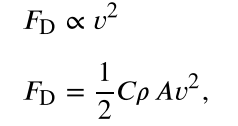Chapter 5: Further Applications of Newton's Laws: Friction, Drag, and Elasticity
1/14
There's no tags or description
Looks like no tags are added yet.
Name | Mastery | Learn | Test | Matching | Spaced |
|---|
No study sessions yet.
15 Terms
deformation
change in shape due to the application of force
Drag force
found to be proportional to the square of the speed of the object; mathematically where C is the drag coefficient, A is the area of the object facing the fluid, and p is the density of the fluid

Friction
a force that opposes relative motion or attempts at motion between systems in contact
Hooke’s Law
proportional relationship between the force on a material and the deformation it causes

Kinetic Friction
a force that opposes the motion of two systems that are in contact and moving relative to one another
magnitude of kinetic friction
where uk is the coefficient of kinetic friction

magnitude of static friction
where us is the coefficient of static friction and N is the magnitude of the normal force

shear deformation
deformation perpendicular to the original length of an object; where S is the shear modulus and F is the force applied to perpendicular to L0 and parallel to the cross-sectional area A

static friction
a force that opposes the motion of two systems that are in contact and are not moving relative to one another
Stoke’s Law
where r is the radius of the object, n is the viscosity of the fluid, and v is the object’s velocity; gives drag force for small objects moving in a denser medium

strain
ratio of change in length to original length; a unitless quantity

stress
ratio of force to area; measured in N/m2; equals to Y x strain

tensile strength
the breaking stress that will cause permanent deformation or fraction of a material
Relationship between the deformation and the applied force
where Y is s Young’s modulus, which depends on the substance, A is the cross-sectional area, and L0 is the original length.

Relationship of the Change in Volume to other physical quantities
where B is the bulk modulus, V0 is the original volume, and F/A is the force per unit area applied uniformly inward on all surfaces
